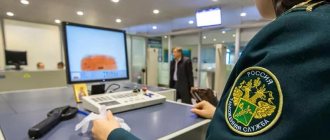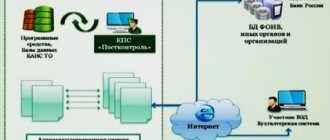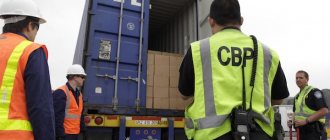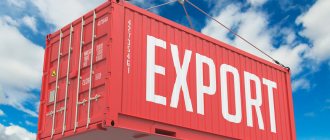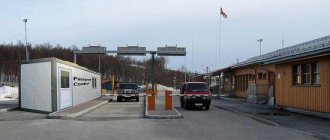Today, customs authorities of all countries must follow the constantly changing parameters of global trade relations. From a global point of view, they are obliged to contribute to their improvement, but from the point of view of a particular state, their direct duty is to suppress and prevent violations of the law in the field of customs rules, which serves the common cause of ensuring security. In this dual and non-trivial situation, the use of information technologies in the field of customs procedures becomes very useful.
Issues of assessing the effectiveness of the implementation of information technologies in the activities of customs authorities
- expanding interaction with other control authorities in terms of submitting permits in electronic form and organizing a unified system of interdepartmental electronic interaction, both when declaring goods and when crossing the customs border;
formation of a single end-to-end array of documents about the consignment, starting from its arrival at the customs territory, and ending with control after the release of the goods;
A promising conceptual scheme of interaction in the process of information exchange, formed in the process of implementing the above areas, may look like it is presented in Fig. 1.
The listed areas will significantly affect:
- configurations of information flows of the information system of customs authorities, both incoming and outgoing;
- on the requirements for the technical parameters of the network on the main lines of data transmission;
- on the functions of individual units of customs authorities, both information units and units exercising customs control, since with centralized processing of data on declared goods, customs officers will specialize in the implementation of actual control (inspection, examination of goods and analysis of paper documents for the consignment );
- on the requirements for the level of qualifications of personnel, both information departments and customs authorities;
- organization of document flow and information resources for participants in foreign trade operations, carriers, as well as on the functional responsibilities of their personnel and personnel qualifications.
In this regard, the assessment of implemented projects from the standpoint of their economic efficiency seems important. The need to consider this aspect of activity is also related to the following:
- almost the entire range of government functions assigned to customs authorities, including declaration processes and the implementation of services performed at the request of foreign trade participants, is implemented through the use of information technology;
- the use of information technologies influences the configuration of business processes for the implementation of customs operations and organizational and structural changes in the customs authorities themselves;
- information technology is the main factor in reducing the time required for customs operations and improving the quality of customs services;
- the costs of modernizing and maintaining the information system of customs authorities in working order are more than significant. They include both the costs of maintaining information infrastructure in the form of communication channels, switching equipment, technical means of protecting information resources, etc., and the costs of maintaining an up-to-date set of software tools in order to ensure their compliance with the requirements of customs legislation.
From the nature of the functioning of information systems, it follows that when assessing the effectiveness of the functioning of an information system, it is necessary to take into account not only the capital costs of creating or modernizing the information system, but also the current costs of its operation. Experts in the field of information technology testify that the cost standards for maintaining any information systems amount to about 70% of the cost of the system [1, p.45].
However, the most difficult task of assessing the effectiveness of this area of activity is evaluating the results. As a rule, the following are the results of implementing (improving) an information system:
- improving the organization's performance indicators;
- increasing the volume and reducing the processing time of information;
- reduction in staffing requirements;
- increasing labor productivity;
- emergence of new opportunities.
However, it is quite difficult to isolate the influence of the information system on the listed parameters, since its modernization is accompanied by organizational and structural decisions.
Taking into account many years of experience in the use of information systems in the customs authorities of Russia, and the difficulty of identifying individual emerging effects of automation on the activities of customs authorities, it seems that the choice of a method for assessing the effectiveness of the use of information technologies in customs operations should be based on a comparison of the results achieved in past periods and planned future parameters . In other words, it should be based on comparative economic efficiency methods. The approach to the methodology for calculating the indicator should take into account the following.
In terms of costs, provide:
- comprehensive accounting of all necessary costs, including both technical and program measures, as well as the restructuring of the management of customs authorities, personnel training, etc.;
- taking into account the time factor;
In terms of results, ensure:
- comparability with the results of previous years;
- accounting for incoming cash flows based on discounting principles;
- the possibility of linking with performance indicators of customs authorities;
- the ability to evaluate the results of implementing an information system in individual structural divisions with subsequent aggregation of indicators at a higher level;
- assessing the impact of synergistic effects of automation on the business community;
- the ability to assess the impact on the formation of proportions at the macro level, formed in the process of implementing customs policy.
Thus, the result of the activities of a structural unit of customs authorities may look like:
(1)
Where,
TP1, TP2 – respectively, the result of the base and perspective periods.
The Law of the Russian Federation “On Customs Regulation”, as one of the main indicators of the efficiency of customs authorities, provides for the use of such an indicator as “timeliness and completeness of receipt of customs payments” [1, Article 18].
Accordingly, the increase in the amount of customs payments transferred to the budget can be used in indicators for assessing the effectiveness of the implementation of information technologies. If necessary, the increase in customs duties can be obtained by eliminating the influence of the level of rates and the tax base. At the same time, it seems necessary to formulate this indicator taking into account the discounting principle, since the state is not indifferent to the cost of funds that will be received in future periods.
The total cost of automation consists of the cost:
- computer equipment;
- network and other equipment;
- software products and license fees;
- costs for installation, implementation, adaptation, study and maintenance of software systems;
- costs of organizational and structural changes, including personnel changes and possible savings from staff reductions;
- training;
- current expenses for electricity, communications, rent of premises;
- possible costs for upgrading intra-office local data networks, etc.
When calculating costs, a comparison is also made of costs incurred in previous periods and currently.
Thus, the effect of introducing automation is calculated as an increase in customs payments to the costs of automating the process of carrying out customs operations.
Eav
(2)
Where,
Eav – effect of automation;
TP1-TP2 – change in the resulting indicator (
;
Z1-Z2 – difference in costs between new and old automation options (
.
Considering the importance and significance of operating costs when using information systems in efficiency calculations, it is advisable to present the total costs as the sum of one-time and current costs reduced to a comparable form. Taking into account the different times of investments and receipts of customs payments, costs and results also need to be brought to a comparable form, for example, at the time of the first tranche for modernization of the information system of customs authorities. Many methods suggest doing this based on the discounting method, based on the fact that money received later costs less than money received in earlier periods of time. This approach is fully consistent with the idea of reducing the time required for customs operations, i.e. the formula for calculating the effectiveness of implementing information systems in customs authorities will take the form:
(3)
Where,
Кd – discount factor.
The discount factor is calculated using the well-known formula for bringing cash flow in the form of changes in the volume of collection of customs duties to the period of the beginning of a new stage of automation.
(4)
Where,
En is the standard coefficient of efficiency of capital investments, which can either be calculated for similar projects, or the refinancing rate of the Central Bank of the Russian Federation can be taken as it;
to – year to which the value of the indicator is given;
tm is the year under consideration.
This indicator, reflecting the increase in the collection of customs duties per unit of current and one-time costs spent, can be calculated for different segments and hierarchical levels of the customs information system. It can be supplemented by private indicators, such as an increase in personnel productivity, which is quite significant for customs authorities at the present time.
Literature:
1. Law of the Russian Federation “On customs regulation in the Russian Federation” dated November 27, 2010, No. 311-FZ: [Adopted by the State Duma of the Russian Federation on November 19, 2010; approved Federation Council November 24, 2010] [Electronic resource]. https://www.customs.ru (access date: 03/14/2013).
2. Yurlov F.F. Methods and models in economics: monograph. – N. Novgorod: NSTU Printing House, 2010. – 217 p.
Specialization “Customs control using information systems and customs technologies”
It is no secret that in recent years the volume of trade and economic transactions between Russia and foreign countries has grown significantly, and according to official statistics it is growing by 10-15% year on year, while the need for qualified specialists is growing at an even faster pace. Digital technologies in customs have been used not so long ago, but have already firmly captured the entire customs space. The first electronic declaration was filed in 2008. Now we can say that the Federal Customs Service of Russia has digitized all customs procedures.The Customs Service annually processes about four and a half to five million customs declarations. That is, somewhere between 12-15 thousand declarations daily. Just imagine the volume of activity: hundreds of items in the product range, hundreds of products, thousands of documents, and so on every day. All this needs to be accepted, assessed, and a request must be made to the electronic resources of other Federal executive authorities. And if such an opportunity exists, then to the information resources of our foreign partners. Then assess, identify risks and minimize those risks. It’s quite understandable - in order to analyze such large volumes of data, you need an appropriate IT architecture; future specialists will be able to study all this after mastering this specialization.
During training, future specialists gain skills in conducting customs control, can independently determine the cost of goods and the country of origin, and also study the process of collecting and returning customs duties.
The specialization is aimed at training erudite specialists capable of solving complex problems and navigating the dynamically developing digital sector of the customs service. Specialization provides a full range of knowledge, sufficient both for the effective management of IT projects in customs and to meet the needs of the best employers in the field of foreign trade.
The future specialist must be able to identify and suppress various administrative offenses and crimes, manage customs authorities (introduce planning, analysis and control of activities), use information systems and technologies, as well as means to protect information from third parties, to achieve the above goals.
The peculiarity of the specialization is that a specialist in this field of customs services must have an excellent understanding of the legislative framework, know the rules of international trade, be able to correctly classify goods for customs purposes, and know all the intricacies of declaration and supply chain management. Students specializing in “Customs Administration in the Digital Economy” study disciplines that form the most complete understanding of business processes and government management processes in customs. Among the current specialized disciplines we can highlight the following: “Information customs technologies”, “Information systems”, “Declaration of goods and vehicles”, “Currency regulation and exchange control”, “Customs payments”, etc.
Thanks to a well-organized list of disciplines, the future specialist will develop very well his powers of observation, analytical skills, intuition, and professional competence. These qualities, without any doubt, are useful not only when performing professional duties, but also in everyday life. And the skills and knowledge in the field of jurisprudence and foreign economic activity acquired during the study will make it possible in the future to easily obtain the desired position in the organization.
Having acquired this profession, you can count on financial stability, demand, and prospects.


